Feather footed chickens are a great addition to your flock if you’re looking for something new. You can find chickens with fully feathered legs and breeds with giant bell bottoms.
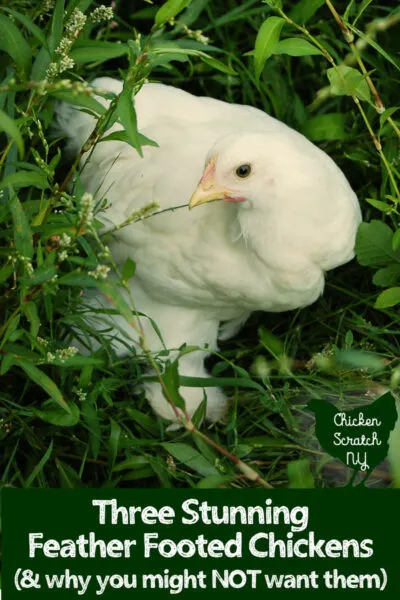
Other than looks feathered feet don’t offer any extra benefits. Even though it would be really cool if it gave the ability to walk on water like the basilisk lizard.
There are a few challenges unique to keeping birds with feathered feet. Most are environmental and easy to solve but one is medical in nature.
Fighting with Mud
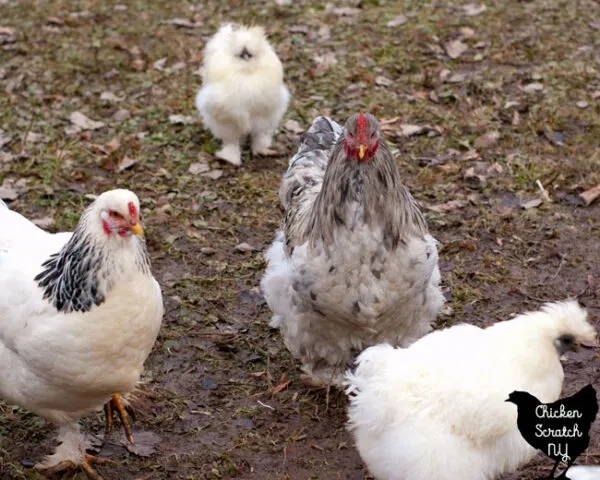
The biggest issue is with mud. I free range my birds and living in the North East we get lots of it. There are actually very few months where there isn’t at least a little mud.
The problem with mud and chickens with feathers on their feet shows up in the nest box. All those lovely feathers carry mud from the ground, into the nest box and onto the eggs.
I don’t wash fresh eggs unless absolutely necessary, the really gross ones go into a carton for my dog and the rest get wiped off before use.
Obviously, you don’t need feathered feet to track mud onto eggs but it’s definitely a much bigger issue with the feather-legged chickens.
Read more about What to Expect from Farm Fresh Eggs
Keeping Eggs Clean During the Mud Season

Assuming you can’t avoid the mud and you need to let your birds outside there are a few things you can do to keep the mess down.
Extra Bedding
Try to keep the coop floor covered in a thick layer of bedding; wood shavings, straw or dried leaves work well. It’ll help get the mud off their feet as they walk in to the coop.
Longer Distance to the Nest Boxes
It also helps if they need to take a longer walk from the door of the coop to the nest boxes, depending on the layout and size of your coop that may not be possible.
The further they have to walk through the bedding, the more time it has to soak up some of the mud and wetness.
Keep them Inside Longer
Most chickens lay early in the day and if they lay their eggs before they get a change to get muddy your eggs will stay cleaner.
I have to open up my coop before I leave for work so this doesn’t work for me but other people have had luck with it.
Foot Feather Problems
Chickens can get ingrown feathers anywhere, I’ve had a few hens get them on their backs. I think they were caused by roosters being roosters when the ladies were molting.
But by far the most cases of ingrown feathers have been on my birds feathered feet.
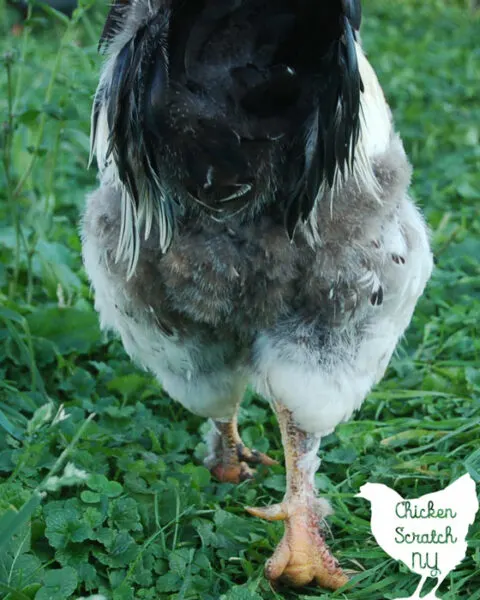
In the picture above you can see the red and irritated patches on the outsides of the feet where the feathers should be.
This guy was my favorite rooster, his name was Bruce. I soaked his feet in warm Epsom salt water and rubbed away the casings that grew over the feathers.
The feathers were small and curled into balls, most of them fell out when I rubbed off the covering but a few I pulled out. I was afraid they would end up bleeding and cause more issues if I left them in.
Read more about Blood Feathers & What to do if they Break
He had a lot of foot problems in his old age, I think it was gout which causes swelling in the feet. Gout can be caused by too much calcium and a large breed rooster eating layer is a good way to get too much calcium.
Types of Feather Footed Chickens
When it comes to feather footed chickens you have quite a few options. Today I’m going to share three of my favorite chicken breeds.
They’re all birds that I have in my current flock and the cover the whole size spectrum so there is something for everyone!
It’s worth noting that the majority of my random barnyard chicken photos feature these three breeds, even though I have more than a dozen types of chickens at this point.
All three of these breeds are homebodies, they enjoy ranging but tend to stick close to home (unlike the ducks that spend more time with my neighbors than with me) and don’t take off when the camera comes out.
Brahma Chickens
We’re going to start with my favorite chickens, many years ago I asked a bunch of my favorite homestead bloggers about their favorite chicken breeds, even then I had my Brahmas at number one.
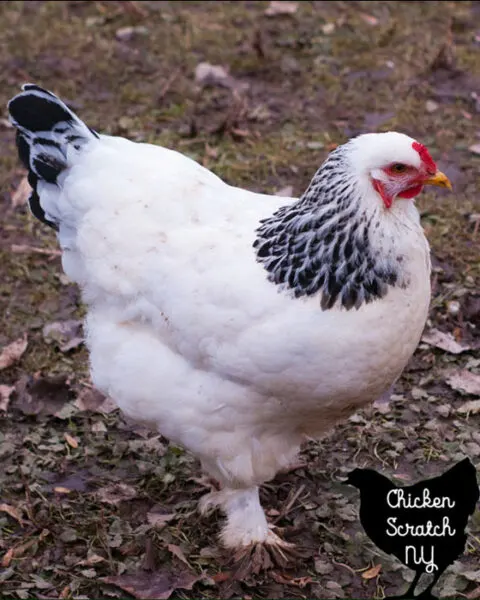
Brahmas are everything I look for in a chicken; giant, fluffy, calm, hardy, and friendly.
They’re some of the biggest chickens you’ll come across, full-grown roosters weigh in at 12 pounds and hens at 9.5 pounds. Once you add a mountain of fluffy feathers to that you’ve got quite a large bird on your hands.
Do you Need a Rooster in Your Flock? Find out
Thanks to that large size they’re also useful as a meat bird. You’re looking at a longer turn around time than with a cornish cross but you’ll still end up with a decent sized bird on the table.
Brahmas are known for their docile personalities, going broody and laying 150+ medium-large brown eggs each year. They have a small pea comb making them a great option for raising chickens in a cold winter climate.
Even better they have a reputation for laying the majority of their eggs in the colder winter months when everyone else is resting after the fall molt. I have a variety of egg layers but I do notice a shift from a lot of blue eggs to a majority of brown eggs in the winter when the Easter Eggers take a break.
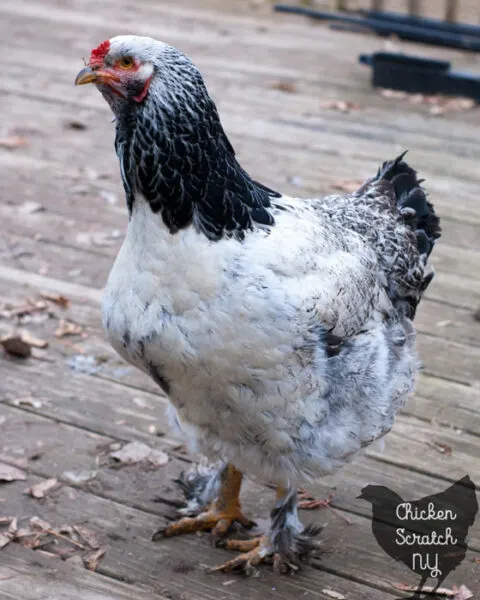
One thing to keep in mind when adding giant birds to your flock is the need for lower roosts. I have two sets of roosts, one is about 6.5 feet off the ground and the other is the DIY folding roosts I made with my daughter.
The chickens self-segregate with the lighter-bodied birds like the EEs & my Appenzellar Spitzhaubens hanging out up top and the larger birds, Brahmas & Cochins, preferring the lower roosts.
They come in three color variations, the most common is the Light Brahma, which is what I have. It’s harder to track down and you’ll pay more but you can order Buff and Dark Brahmas from online hatcheries.
You can also find bantam Buff Brahmas. I’ve never raised them, my love for Brahmas is directly linked to their size and I try to keep my bantam numbers low or I end up with dozens of tiny eggs that no one but my 3 year old wants haha.
Out of my original flock I had two Brahma hens make to old age, one died at 9 and the other made it almost to 11. The Livestock Conservancy isn’t kidding when they call these birds hardy!
Cochin Chickens
The next magically fluffy bird on our list is the Cochin. They’re actually pretty similar to the Brahmas; they also come in both standard and bantam sizes and they’re in the Asiatic class (originated in Asia).
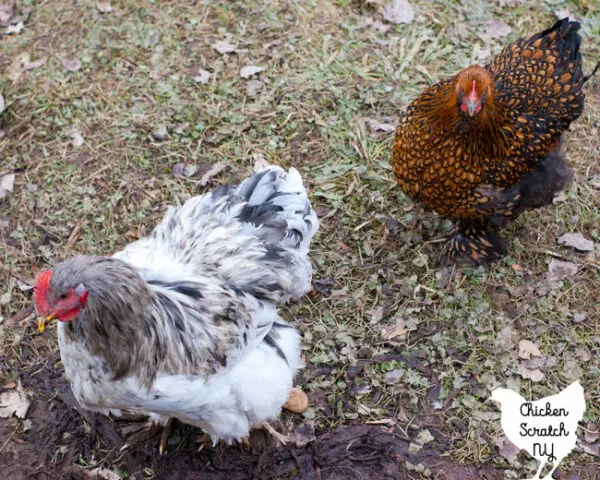
They also lay medium-large brown eggs and can be used as a dual-purpose breed for both eggs and meat. Cochins are known for a docile temperament and going broody.
That big guy is “Super Fluffy” and he’s a real sweetheart. When we were overrun with roosters earlier this year the younger ones kept him out of the barn.
Finding Super Fluffy became a nightly ritual and he became quite fond of eating out of my hand.
They’re large birds but not quite as weighty as the Brahmas. The roosters and hens are about a pound lighter at 11 and 8.5 pounds.
Even with all that in common, it’s quite easy to tell them apart at a glance. Brahmas have feathered feet, which gives them a bell-bottom silhouette.
Cochins have fully feathered legs and that makes them look like a ball. A round, fluffy chicken ball.
They come in a dizzying variety of colors, with over 15 recognized color patterns in both the standard and bantam sizes. Right now I have splash Cochin hens, a splash rooster and gold-laced Cochin hens that I call my Halloween chickens.
Cochins have a single comb, making them less than my personal ideal for the New York winters. You don’t get the frostbite issues with smaller comb birds.
Learn more about 3 Hardy Heritage Breeds Bred for Cold Weather
Silkie Chickens
Last but not least we have the Silkies, another Asiatic class chicken, these guys are the teddy bears of the chicken world.
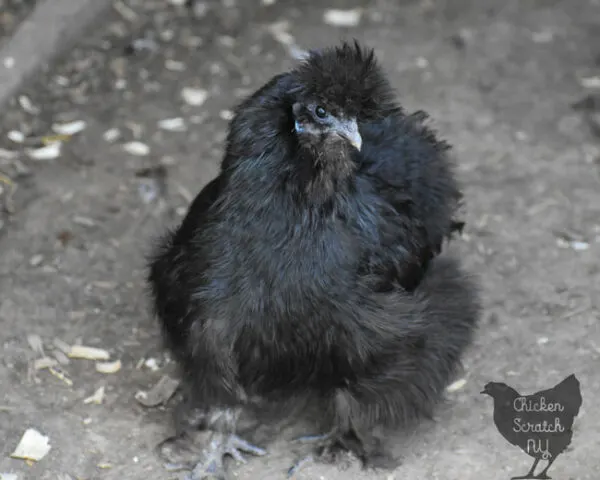
They have several unique features that make them stand out against any other chicken, as a result Silkies are the easiest chicks to identify in a crowd.
Read more about Identifying Chick Breeds
They have black skin, extra toes and very soft, fur-like feathers.
The special feathers make it a bit trickier to sex Silkies, the standard clues that differentiate hens and roosters are harder to see. The best clue is the extra ‘streamers’ coming from the head pouf on a rooster and a larger size.
They’re not the best layers, they are more ornamental than practical. They fit nicely in my mixed flock and they’re tiny enough that that don’t much.
And my kids love them, they’re just so cute it’s impossible not to love them.
Even though they have literal free range of the place the Silkies stay closest to home, I rarely even see them in front of the house. If you can’t (or decide not to) free range your birds you’ll want to be more careful about mixing tiny birds in with the giants.
Read more about Bantam Chickens
One big problem with Silkies is a higher chance of wry-neck. Wry Neck is a condition where the chicks turn their heads to the side, some times it’s so bad that the chicks begin to walk backward and can starve to death.
Silkies (and Polish) chicks are more susceptible due to a difference in their skull shape. The best way to prevent head injuries is to brood Silkies separately from other birds, especially larger ones.
Do you have feather footed chickens? Don’t forget to PIN this to you chicken board for later!
Looking for more information? Check out my Chickens page or start here:

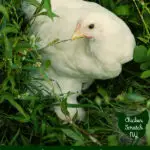
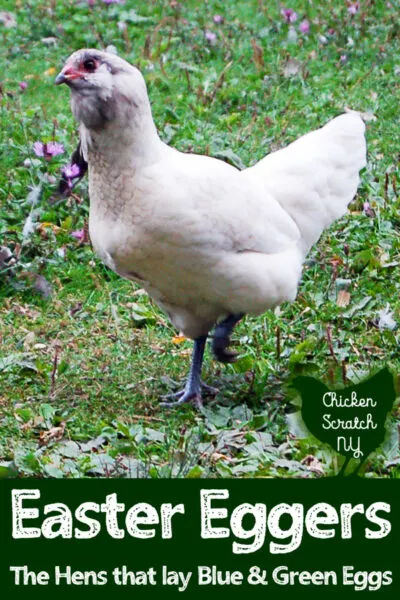

Lisa
Sunday 1st of May 2022
I would love to know where I can find more information on raising foot feathered chicks? My French Marans are about two weeks old and I am not as informed as I should be. The 'Foot Feather Problems' section was great but it's not the easiest subject to research.
Alecia
Tuesday 3rd of May 2022
I don't think it's a topic many people cover because other than the mud issue and the things I mentioned in the article it's really not much different than raising regular clean-legged chickens.
I've noticed they're more likely to get things wrapped around their toes and they get the occasional ingrown feather on their feet, you can watch out for those things but Marans toe feathers are pretty sparse compared to a cochin or a silkie so you're probably not going to have any issues at all. Good luck with your babies!